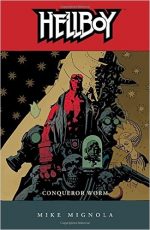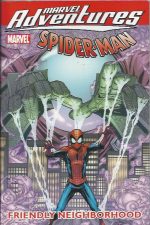
By Andi Watson, Christopher Golden, Daniel Brereton, Joe Bennett, Hector Gomez, Cliff Richards, Jason Minor & various (Dark Horse)
ISBN: 978-1-59307-968-0
It’s the height of summer here and with “Seen-it Season†well under way and nothing but old movie blockbusters and sundry other reruns flooding the TV ether, I’ve decided to join in the lazy, short-sighted scheduling process with a few comics compilations starring venerable franchise stars. At least the entertainment quality of these golden oldies is guaranteed and there are no ads to fast forward through…
Buffy the Vampire Slayer debuted as a motion picture starlet, but found her home after migrating to the small screen. After securing her status as a certified media sensation, she won her own comicbook in 1998, with smart, suspenseful, action-packed yarns exploding out of a monthly series, graphic novels, spin-off miniseries and short stories in showcase anthology Dark Horse Presents – all complementing the sensational, groundbreaking and so culturally crucial TV show.
Buffy Summers resides in the California hamlet of Sunnydale, built over a paranormal portal to the Nether Realms dubbed The Hellmouth. Here, she and a small band of buddies battle devils, demons and all sorts of horrors inexorably drawn to the area: most of whom/what regard humanity as a succulent appetiser and Earth an irresistible eldritch “fixer-upper†opportunity.
With Rupert Giles, scholarly mentor, father-figure and Watcher of all things unnatural, Buffy and her “Scooby Gang†sought to make the after-dark streets of Sunnydale safe for the largely-oblivious human morsels, ably abetted and occasionally aided by an enigmatic undead stud-muffin called Angel…
Collected in this fourth of seven supremely scintillating Omnibus editions (and mirroring events on the show’s third season) are the pertinent contents of Dark Horse Presents #141, Buffy the Vampire Slayer #9-11, 13-15, 17-20 and 50, Buffy the Vampire Slayer Annual 1999, Buffy the Vampire Slayer Wizard #½, Buffy the Vampire Slayer: Angel #1-3, Buffy the Vampire Slayer: Lover’s Walk and Angel #1-3: collectively spanning 1999-2002 and all re-convened for your delectation as a chronological continuity rather than in original publishing order: well-nigh 400 pages of full-colour mystery, merriment and mystical martial arts mayhem.
As recapitulated in original series Editor Scott Allie’s Introduction, although stories were created in a meandering manner up and down the timeline, this Omnibus series offers them in strict chronological continuity order…
Launching the sundown action is an ambitious 10-issue epic which ran intermittently through the first two years of the monthly comic. ‘Bad Blood’ was written by Andi Watson and illustrated by Joe Bennett & Rick Ketcham and latterly Cliff Richard & Joe Pimentel, opening with a rare romantic moment. Buffy and recently-restored undead lover Angel are in the local cemetery where they are interrupted by a new type of threat. However this particular monster is too quick to be seen and apparently consumes corpses rather than living flesh…
Meanwhile, in a dingy alley formerly beautiful vampire Selke seethes. Even though her kind cast no reflections, she knows her previous clashes with the Slayer have destroyed not only her strength but also her sublime allure…
Even as Buffy’s mom idly considers cosmetic surgery to bolster her fading youth, Selke accosts plastic surgeon Dr. Flitter, offering the challenge of a lifetime and unchanging, undead eternal life in return. Obsession with appearances seems to be epidemic in Sunnydale and when Buffy is approached by talent scout Lana she seriously considers a proposal to become a model. If only it doesn’t cut into her Slaying schedule… oh, and school of course…
Whilst Giles was busy researching the elusive thing that eats cadavers, Ma Summers has regained her equilibrium and decides against going under the knife – which was lucky since Flitter has taken up Selke’s offer to restore her. However, as his normal procedures don’t work, he’s resorting to old books of magic for a solution, and is keeping the impatient nosferatu complacent by feeding her his other clients…
Buffy has prepared to battle what Giles calls “Ghouls†but faces a far worse, emotional, battering from the other models on her first day at work. Selke, meanwhile, fooling herself that Flitter’s efforts are working, has tried to recruit vampire allies from the town’s new undead overlord Rouleau and been utterly humiliated…
Later that night as Angel and the Slayer finally eradicate the ghoul gang, furious Selke puts her increasingly arcane cosmetologist on warning: succeed soon or die horribly… Issue #11 continued exploring themes of looks and sexual politics after sleazy musician Todd Dahl hits town with his band and starts looking for impressionable babes to bed.
After the Slayer forcefully turns him down, Todd brags that he has bagged Buffy and goes on to insult and rebuff more-than-willing teen witch Amy. All too soon, the repulsive love-rat is treated to a scary look at the other side of the bed when he suddenly transforms into ‘A Boy Named Sue’…
Flitter meanwhile has intercepted a grimoire intended for Giles’ lore library and deduced a way to heal Selke and even hype-up the strength of her own bite-created offspring. Unfortunately, it involves preying upon other vampires to get the raw ingredients…
The direly dangerous process succeeds and a fully restored, resplendent, deadlier than ever Selke triumphantly puts her plans into play. Soon everyone who ever crossed her will pay and pay and pay in blood and torment…
The wise-cracking action resumes with the formerly disfigured and depleted Selke paying a return visit to undead gang-boss Rouleau. The last time he saw – and spurned – her, she was a pathetic, mutilated bag of scars and bile, but now she is both beautiful and overwhelmingly powerful. She also bears a grudge…
Her pet plastic surgeon has discovered a passion for alchemy to supplement his total lack of morals. Flitter has completely taken up Selke’s cause, restoring and improving her but, since normal scientific procedures don’t work, is stuck with scouring books of magic for a solution. Although his researches turned up a way to turn vampire blood into a super-steroid for Selke and her “offspringâ€, now she and her newly-minted children of the night must hunt not only humans for food, but vampires for fuel…
Selke, though, is obsessed only with making the Slayer suffer…
Meanwhile, in a vain semblance of normal teen life, the Scooby Gangsters Cordelia, Oz, Xander and Buffy coach brainy, nervous Willow for an upcoming televised inter-school quiz show. Things start to come unglued when Selke incidentally consumes Sunnydale High’s resident nerd Lyle and Cordy, desperate to change her bimbo image, steals a magic charm from Giles and becomes a voracious consumer of facts. Sadly, there’s no off-switch and her brain quickly begins to overload…
Selke’s über-vamps are also making mischief with Buffy and Angel finding them almost impossible to destroy…
Now nocturnal civil war breaks out between Selke’s squad and the town’s regular fangers. Night patrols are crazily broken up by vampires constantly attempting to capture and drain each other, and things take a bleak turn when deadly demon lovers Spike and Drusilla return, keen on turning the mounting chaos to their own decadently amused advantage…
Soon, their unique talents for obtaining information have led them to the secret of the “bad bloodâ€, with Selke and Flitter still oblivious to the new threat to their schemes. The cosmetic alchemist has now discovered a way of mystically cloning their own “Dark Slayer†to take care of Buffy, and Selke wants one right now!
Sadly Flitter’s first attempts are all woefully inadequate and promptly discarded… even the one which was still sort-of alive…
Buffy’s daylight problems are insane. Sleazy Todd spread very nasty rumours about her before he temporarily turned into a girl, but now he’s male again he’s fallen desperately in love with the girl he wronged. His misplaced passion and rekindled conscience cost him dearly…
Events reach crisis point as the war between leeches escalates. On a rare night off from slaying, Buffy hits one of Selke’s pack with her mom’s (stolen) car and is subsequently ambushed by the whole mob. Even as she impossibly stakes them all, in a hidden lab, Flitter decants his masterpiece – a Summers simulacrum physically identical to and apparently far superior to The Slayer. This sorcerous clone will relentlessly hunt down and slaughter the original…
Accursed by daylight lives approximating normality, Willow, Cordelia, Oz, Xander and Buffy are forced to join in school-type activities by building a float for an upcoming parade. Angel, meanwhile, has captured one of Selke’s new ‘Roid Rage Vamps and started obtaining answers in a manner most un-heroic…
On the midnight streets, Buffy is ambushed by her duplicate and, after a blistering battle, loses. Elsewhere Selke, unaware that a new faction has sabotaged her modified blood supply, gorges herself on the foul brew…
After disposing of Buffy’s body down a handy manhole, the doppelganger attempts to infiltrate the Scooby Gang, but although she has the Slayer’s memories, her attitudes are seriously skewed. For instance, her knowledge of fashion now rivals Cordie’s…
Tensions rise as the clone starts to degrade. Born of Bad Blood, she casts no reflection and can’t see her face, but once she notices the flesh of her shoulder coming off she heads straight back to Doc Flitter…
The cosmetic alchemist has already discovered that someone has adulterated his buckets of blood and Selke is completely out of control when the clone arrives, leaking from many lesions. None of them are aware that, deep below Sunnydale’s streets, Buffy is slowly recuperating, assisted by a shambling earlier prototype previously discarded by Flitter.
As Angel sneaks in and destroys the reservoir of augmented blood, the raging, oblivious Selke orders the duplicate to fetch Buffy’s body and prove she’s dead…
The gory carnival of chaos cataclysmically concludes when the clone confronts the Slayer and her earliest incarnation in the sewers, whilst above ground Willow and Giles examine “Buffy’s†blood on a discarded parade costume and uncover the awful truth…
When Selke sees the decimation wrought by Angel, she goes berserk; her form rapidly mutating into monstrosity, just as the long-awaited procession begins through Sunnydale. Her depredations are interrupted by the battered but victorious Buffy who spectacularly re-emerges to destroy Selke and end the Bad Blood menace forever. However, in the shadows, deadly demon lovers Spike and Drusilla fade from sight, taking new toy Dr. Flitter with them…
A selection of Short Stories comes next, beginning with ‘Bad Dog’ by Doug Petrie, Ryan Sook & Tim Goodyear from Buffy the Vampire Slayer Annual 1999. It depicts how the Slayer, whilst hunting for reluctant werewolf Oz on one of his “wild†nights, encounters a nasty young sorcerer determined to turn himself into a god at gal-pal Willow’s expense…
‘Hello Moon’ – written by Daniel Brereton & Christopher Golden, with art by Bennett & Jim Amash – was the first of three tales from Dark Horse Presents #141: a thoughtful vignette wherein Buffy instinctively attacks a monster on the beach only to realise she has much in common with her target.
The beleaguered fish-man also bears the weight of unwelcome responsibility for his endangered race. No sooner have these two champions made their peace, however, than a band of roving vamps attacks…
From the same source, ‘Cursed!’ by Golden, Hector Gomez & Sandu Florea then sees brooding Bad Boy Angel guiltily regaling Buffy with the horrific events he perpetrated following his rebirth as a bloodsucker in Ireland circa 1753…
Watson, David Perrin & Florea round out the DHP #141 appearances with a glimpse at Giles’ early career as a supernatural investigator tackling a nasty case of bodysnatching, resurrectionism, reanimation and ‘Dead Love’…
‘Stinger’ – by Golden, Gomez & Florea – comes from promo premium Wizard #½ – detailing how Xander’s attempts to save Willow from a bullying stalker lead to a clash with a fear-feeding scorpion-thing…
From Buffy #50, Andi Watson contributes hilarious change-of-pace gag strip ‘Mall Rats’ after which Golden & Eric Powell expose ‘Who Made Who’ (Buffy the Vampire Slayer: Lover’s Walk) with Spike and Dru’s notoriously “open†relationship going through one of those spiralling phases that always results in jealousy, spite and mass-slaughter…
Angel eventually spun off into his own TV series, but from the start was a big enough draw to earn his own comicbook title. Angel: The Hollower was a 3-issue miniseries (May-July 1999) and detailed how, even after reverting to exquisite evil before being redeemed again, his past would always haunt him…
It begins in present-day San Francisco where a pair of vampires is attacked by a monstrously tentacled horror. Veteran vamp Catherine barely escapes with her unlife and, having seen the horror before, knows there’s only one being she can turn to…
Back in Sunnydale, Buffy and Angel have resumed their after-dark partnership, even though Giles and the rest of her in-the-know friends are still wary of the recently re-redeemed night-stalker. However, once their monster-killing “date†ends, Angel is jumped by a band of fangers and sees once more a girl he slaughtered and “turned†over a century past…
Although their sworn enemy, his undead captors treat Angel with kid gloves. Catherine only wants to talk, and she wants to talk about ‘The Hollower’ …
A flashback turns to Vienna in 1892 where Angelus and his pack-mates Spike and Drusilla were amongst many vampires preying on the populace in complete security; oblivious of and immune to all threat or challenge.
However, soon after turning Catherine, Angelus was confronted by starving, terrified vampires fleeing some unimaginable horror that actually preyed on bloodsuckers…
Back in the now, Catherine reminds her sire of the cost the last time the creature manifested and warns him it has undoubtedly tracked her to Sunnydale…
Convinced, Angel agrees to a truce and prepares to battle the thing again. Typically he considers this something he cannot share with Buffy…
In end-of-the-century Austria the first fight against the Hollower unsatisfactorily stalled with only a few undead survivors, whilst now in Sunnydale Angel secretly consults eldritch expert Giles and learns the truth about the beast. He also discovers that, blithely unaware, Buffy is already hunting a huge, subterranean tentacle-horror that prefers vamps to human meals…
Watcher archives reveal a chilling scenario. Everybody knows vampires are actually human corpses with the departed soul replaced by a reanimating demon, using blood to fuel the composite creature. The Hollower, however, sucks out those demonic riders and ingests them. That wouldn’t be a bad thing, except once it’s full – about 3,000 demons is its limit – the horror explosively regurgitates them and the partially digested devils will infect the nearest LIVING body.
If the Hollower succeeds in satiating itself in vampire-infested Sunnydale and subsequently pops, most of the town’s mortal souls will suddenly become rabid, blood-crazed killers…
Despite being fully engaged in the hunt, Buffy can’t shift a nagging, tempting and unworthy notion: if the Hollower sucks out the vampiric part of Angel, will she be left with a normal human lover…?
Whatever the outcome, the Hollower has to be stopped at any and all costs…
The manic mystic mayhem then concludes with a comicbook postscript to the Season 3 TV finale as ‘Graduation Day’ (by Petrie, Jason Minor & Curtis Arnold, from Buffy #20) simultaneously follows Angel as he heads for his new mission in Los Angeles and stays in Sunnydale with Buffy when a demon who feeds on lost hope targets both monster-hunters at once, eager to destroy them both at their lowest emotional ebb…
Supplementing this compilation of mystic madness are Title Page and Cover Galleries with material from Jeff Matsuda, Jon Sibal, J. Scott Campbell, Alex Garner, Liquid! & Guy Major to complete the eerie excitement experience.
Visually compelling, winningly constructed and racing along at hell-for-leather pace, this arcane action fearfully funny fright-fest is utterly engaging even if you’re not familiar with the vast backstory: a creepy chronicle as easily enjoyed by the most callow neophyte as every dedicated devotee.
Moreover, in the era of TV binge-watching, with the shows readily available on TV and DVD, if you aren’t a follower yet you soon could – and should – be…
Buffy the Vampire Slayer ™ & © 1999, 2000, 2001, 2002, 2008 Twentieth Century Fox Film Corporation. All rights reserved.











